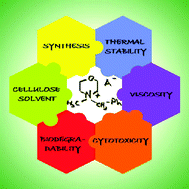Synthesis, toxicity, biodegradability and physicochemical properties of 4-benzyl-4-methylmorpholinium-based ionic liquids†
Abstract
A series of 4-benzyl-4-methylmorpholinium salts have been synthesized producing morpholinium

Maintenance work is planned for Wednesday 1st May 2024 from 9:00am to 11:00am (BST).
During this time, the performance of our website may be affected - searches may run slowly and some pages may be temporarily unavailable. If this happens, please try refreshing your web browser or try waiting two to three minutes before trying again.
We apologise for any inconvenience this might cause and thank you for your patience.
* Corresponding authors
a
Department of Chemical Technology, Poznan University of Technology, pl. M. Sklodowskiej-Curie 2, Poznan, Poland
E-mail:
juliusz.pernak@put.poznan.pl
Tel: +48 61 665 36 82
b
Institute of Industrial Organic Chemistry, Pszczyna Branch, ul. Doświadczalna 27, Pszczyna, Poland
E-mail:
fochtman@ipo-pszczyna.pl
Fax: +48 32 210 30 81 ext. 120
Tel: +48 32 210 30 81 ext. 124
c
Department of Environmental Analysis, Faculty of Chemistry, University of Gdańsk, ul. Sobieskiego 18, Gdańsk, Poland
E-mail:
sox@chem.univ.gda.pl
Fax: +48 58 523 55 72
Tel: +48 58 523 54 48
A series of 4-benzyl-4-methylmorpholinium salts have been synthesized producing morpholinium

 Please wait while we load your content...
Something went wrong. Try again?
Please wait while we load your content...
Something went wrong. Try again?
J. Pernak, N. Borucka, F. Walkiewicz, B. Markiewicz, P. Fochtman, S. Stolte, S. Steudte and P. Stepnowski, Green Chem., 2011, 13, 2901 DOI: 10.1039/C1GC15468K
To request permission to reproduce material from this article, please go to the Copyright Clearance Center request page.
If you are an author contributing to an RSC publication, you do not need to request permission provided correct acknowledgement is given.
If you are the author of this article, you do not need to request permission to reproduce figures and diagrams provided correct acknowledgement is given. If you want to reproduce the whole article in a third-party publication (excluding your thesis/dissertation for which permission is not required) please go to the Copyright Clearance Center request page.
Read more about how to correctly acknowledge RSC content.
 Fetching data from CrossRef.
Fetching data from CrossRef.
This may take some time to load.
Loading related content
